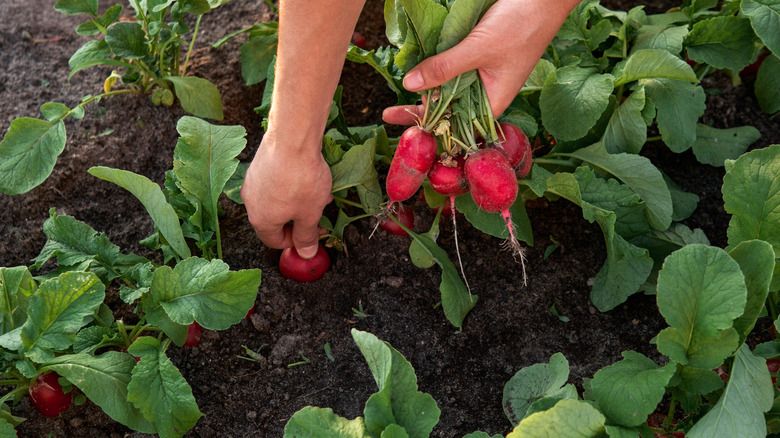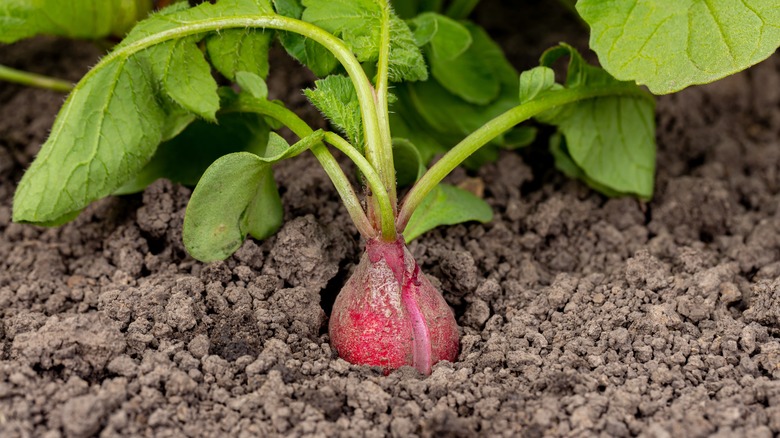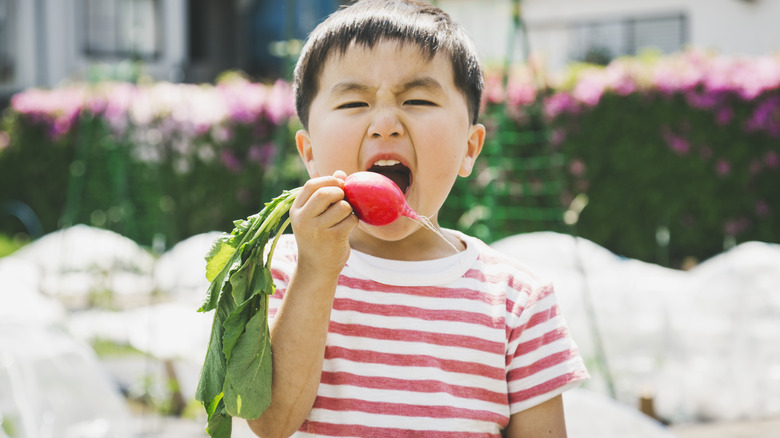Common Issues That Will Have You Think Twice Before Growing Radishes In Your Garden
Radishes are pretty, delicious, and good for you, providing a good source of vitamin C, vitamin B6, calcium, potassium, and iron. However, while they might look beautiful in your garden and on your plate, they're not always the best vegetable for beginner gardeners or those with fragile egos. The reason for this is that radishes are notoriously tricky to grow, and they're an easy crop to ruin if you miscalculate even just one vital resource. For the best results, radishes need extremely consistent water, cool weather, and a quick harvesting time, since they're one of the fastest growing vegetables and can be harvested about 30 to 45 days or so after planting. Miss any of those marks and your radish bulbs could turn out woody, spicy, cracked, or even nonexistent.
Do your radishes have you seeing red? Don't take it personally; these tasty little bulbs are some of nature's most finicky garden vegetables. But if you can take precautions against their most common issues, you'll reveal a crop that's as gorgeous as it is tasty. Here are some of the problems gardeners face with radishes and how to ensure yours come out healthy, plump, and crisp.
Missing or split radish bulbs
You read the seed packet instructions, followed them to a T, and waited patiently for your radishes to grow, but when harvest time finally comes, there are no bulbs underneath those lush greens. What gives? Failure to grow full bulbs and only growing roots and leaves can be caused by hot weather, which makes the plants bolt and go to seed. The optimum temperature for growing radishes is between 50 and 65 degrees Fahrenheit. Another reason radishes may not form bulbs is that they're planted too close together, forcing them to compete for sunlight and grow upward rather than outward. To remedy this, sow the seeds in full sun at least 1 inch apart and thin the seedlings as needed.
For radishes that do develop bulbs, it's crucial to water evenly. Inconsistent watering can cause bulbs to crack and split as they grow, so don't overwater even if there has been a drought. Instead, aim for about 1 inch of water per week, assuming there is no rain. Rather than drenching the garden heavily once a week, try to water lightly a few times a week for a total of 1 inch of water. If your bulbs still split, you can often still eat them, they just won't be as pretty.
Tough or spicy radishes
Radishes are a root vegetable, so they don't really "ripen" and will continue to get bigger as long as they're left in the soil. However, they do have a prime harvesting window, and missing this window can produce roots that taste too "woody." This term means that the radishes are tough, bitter, and dry, or just not so good to eat anymore. A woody taste can also happen if they've taken too long to reach a mature size, which is usually the result of hot temperatures or inconsistent watering. To avoid this, follow the guidelines on the seed packet and use your finger to feel for the top of the radish under the soil. It's better to harvest them a little too soon than too late. However, not all is lost with woody radishes; you can often still pickle them, roast them, or simply enjoy the greens.
Even if you manage to grow normal, healthy-looking radishes, they may not be so pleasant to eat. These vegetables normally have a slightly zesty and spicy flavor — more akin to black pepper than a jalapeno — and there are varieties that are naturally spicier than others. But in some cases, radishes can turn out way too spicy. Like woody radishes, spicy ones are the result of growing too slowly or staying in the garden too long after their prime. Peeling, pickling, or roasting them may be the only way to make their spiciness palatable again.


